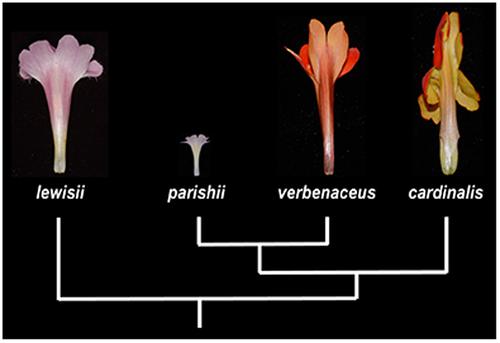当前位置:
X-MOL 学术
›
Evol. Dev.
›
论文详情
Our official English website, www.x-mol.net, welcomes your
feedback! (Note: you will need to create a separate account there.)
Comparative analysis of corolla tube development across three closely related Mimulus species with different pollination syndromes
Evolution and Development ( IF 2.6 ) Pub Date : 2021-01-07 , DOI: 10.1111/ede.12368 Vandana Gurung 1 , Yao-Wu Yuan 1 , Pamela K Diggle 1
Evolution and Development ( IF 2.6 ) Pub Date : 2021-01-07 , DOI: 10.1111/ede.12368 Vandana Gurung 1 , Yao-Wu Yuan 1 , Pamela K Diggle 1
Affiliation

|
Fusion of petals to form a corolla tube is considered a key innovation contributing to the diversification of many flowering plant lineages. Corolla tube length often varies dramatically among species and is a major determinant of pollinator preference. However, our understanding of the developmental dynamics underlying corolla tube length variation is very limited. Here we examined corolla tube growth in the Mimulus lewisii species complex, an emerging model system for studying the developmental genetics and evo‐devo of pollinator‐associated floral traits. We compared developmental and cellular processes associated with corolla tube length variation among the bee‐pollinated M. lewisii, the hummingbird‐pollinated Mimulus verbenaceus, and the self‐pollinated Mimulus parishii. We found that in all three species, cell size is non‐uniformly distributed along the mature tube, with the longest cells just distal to the stamen insertion site. Differences in corolla tube length among the three species are not associated with processes of organogenesis or early development but are associated with variation in multiple processes occurring later in development, including the location and duration of cell division and cell elongation. The tube growth curves of the small‐flowered M. parishii and large‐flowered M. lewisii are essentially indistinguishable, except that M. parishii tubes stop growing earlier at a smaller size, suggesting a critical role of heterochrony in the shift from outcrossing to selfing. These results not only highlight the developmental process associated with corolla tube variation among species but also provide a baseline reference for future developmental genetic analyses of mutants or transgenic plants with altered corolla tube morphology in this emerging model system.
中文翻译:

三种具有不同授粉综合征的密切相关的鼹鼠属物种的花冠管发育比较分析
花瓣融合形成花冠管被认为是有助于许多开花植物谱系多样化的关键创新。花冠管的长度通常在物种之间有很大差异,是传粉者偏好的主要决定因素。然而,我们对花冠管长度变化背后的发育动力学的理解非常有限。在这里,我们检查了Mimulus lewisii物种复合体中的花冠管生长,这是一种新兴的模型系统,用于研究与传粉媒介相关的花性状的发育遗传学和 evo-devo。我们比较了蜜蜂授粉的M. lewisii、蜂鸟授粉的马鞭草属 植物花冠管长度变化相关的发育和细胞过程,以及自花授粉的Mimulus parishii。我们发现在所有三个物种中,细胞大小沿成熟管分布不均匀,最长的细胞恰好位于雄蕊插入部位的远端。三个物种之间花冠管长度的差异与器官发生或早期发育过程无关,但与发育后期发生的多个过程的变化有关,包括细胞分裂的位置和持续时间以及细胞伸长。小花M. parishii和大花M. lewisii的管状生长曲线基本没有区别,除了M. parishii管在较小尺寸时停止生长较早,表明异时性在从异交到自交的转变中起着关键作用。这些结果不仅突出了与物种间花冠管变异相关的发育过程,而且为未来在这个新兴模型系统中对具有改变的花冠管形态的突变体或转基因植物的发育遗传分析提供了基线参考。
更新日期:2021-01-07
中文翻译:

三种具有不同授粉综合征的密切相关的鼹鼠属物种的花冠管发育比较分析
花瓣融合形成花冠管被认为是有助于许多开花植物谱系多样化的关键创新。花冠管的长度通常在物种之间有很大差异,是传粉者偏好的主要决定因素。然而,我们对花冠管长度变化背后的发育动力学的理解非常有限。在这里,我们检查了Mimulus lewisii物种复合体中的花冠管生长,这是一种新兴的模型系统,用于研究与传粉媒介相关的花性状的发育遗传学和 evo-devo。我们比较了蜜蜂授粉的M. lewisii、蜂鸟授粉的马鞭草属 植物花冠管长度变化相关的发育和细胞过程,以及自花授粉的Mimulus parishii。我们发现在所有三个物种中,细胞大小沿成熟管分布不均匀,最长的细胞恰好位于雄蕊插入部位的远端。三个物种之间花冠管长度的差异与器官发生或早期发育过程无关,但与发育后期发生的多个过程的变化有关,包括细胞分裂的位置和持续时间以及细胞伸长。小花M. parishii和大花M. lewisii的管状生长曲线基本没有区别,除了M. parishii管在较小尺寸时停止生长较早,表明异时性在从异交到自交的转变中起着关键作用。这些结果不仅突出了与物种间花冠管变异相关的发育过程,而且为未来在这个新兴模型系统中对具有改变的花冠管形态的突变体或转基因植物的发育遗传分析提供了基线参考。











































 京公网安备 11010802027423号
京公网安备 11010802027423号